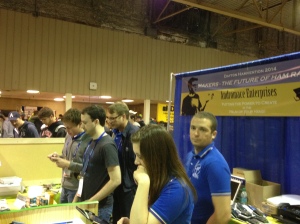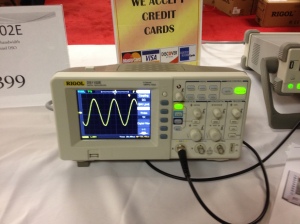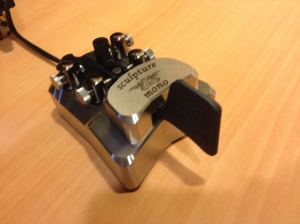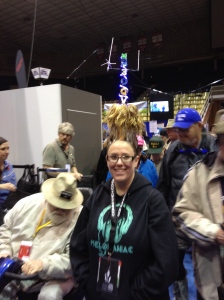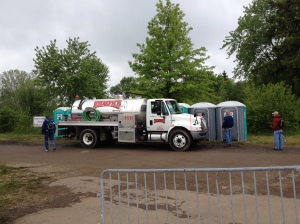Author Archive
 Dayton! (Part 2)
Dayton! (Part 2)
(Continued from the previous article)
The AMSAT forum was overflowing with information. At first I was hesitant to go to a three hour session. While I could sit through long lectures in high school and college, as an adult I get impatient and restless anytime I’m forced to sit for extended periods of time. But the AMSAT forum held my interest the whole time and afterwards I found my way to the AMSAT booth and became a member.
Another forum I attended was the Balloon Satellite / High Altitude Balloon (HAB) forum. Many attendees were from organizations across the country who regularly launch balloons and there were many stories and words of wisdom. I was a sponge soaking it up and came out of the session with dreams of launching a balloon.
As I mentioned in the first part of this article, I think the forums are a real gem at Dayton and well worth the admission price and travel costs. They cultivate thought and interest in amateur radio. The forums definitely recharged my amateur radio mojo.
The theme of the Dayton Hamvention this year was amateur radio operators as Makers. Makers is a modern day term for those who build or homebrew stuff. Some very visible Maker initiatives include Arduinos, Raspberry Pi, and 3D printing.
Busy Folks at a Booth Selling Arduinos and Piece Parts
The Maker theme was a good idea, well intended and timely, however the execution of the theme was lacking. There was only one stand selling Arduino items and another selling Raspberry Pis. I saw only one 3D printer on display. I think there should have been an area dedicated to Maker oriented booths, much like the audio area. A friend commented that a Maker Space would have been a good addition to the hamfest. The vendor selling Arduino items and parts has their booth swamped with people and most of them were noticeably younger folks. Overall I think there needed to be more vendors that were identifiably Maker oriented and some bridge drawn between amateur radio and Maker initiatives.
I remember in the late 80s and early 90s when some amateurs scoffed at the invasion of computers into hamfests, as some regional hamfests were combination hamfests and computerfests. Today you don’t really see this distinction and computers are just an integral part of amateur radio and hamfests. Online I’ve seen some amateurs criticizing the Maker theme at the Hamvention. I see a lot of parallels between the PC era and the Maker movement in progress right now. I think we should embrace Makers in our hamfests. We’ve already seen Arduinos and Raspberry Pis become useful tools, and 3D printers are probably close behind. We need to make a bridge between Making and amateur radio. As we’ve seen with computers and the Internet, communications takes things to new levels. Radio communications equipment and know how are a valuable asset for aspiring Makers and we can draw new people into the hobby with this.
As far as toys that I acquired, besides various piece parts and cable I bought a new Rigol 100 Mhz digital oscilloscope. At the Begali booth I fell in love with the Sculpture Mono paddle. I reached for my credit card and was informed by the salesguy that they only accept cash or checks. I was really put off by this. Later that night I ordered the paddle on the web, at a cost $45 more than the hamfest price and some unknown amount of delivery time. Luckily Begali was shipping recent paddle orders from Ohio so I didn’t wait long.
Dayton Bounty: Rigol Digital Storage Oscilloscope
The BMW of CW Keys
My New Begali Paddle
If I had to do this trip over again, I would have spent much less time in the flea market and would have attended many more forums. While the flea market was huge and had a lot of interested stuff, after awhile each stand and row began to look like the last one. Unless you’re looking for some specific rare item, walking the flea market becomes tedious. I also would have attended the DX dinner and perhaps hit some FDIM events.
Special Entrance for Golf Players
Midway through the hamfest I commented that I wouldn’t attend in 2015 and perhaps might attend again in two or three years. But towards the end and after taking the whole experience in, I decided I would make the pilgrimage again next year if possible. Once you accept Hara Arena for what it is and the oddities and annoyances of many of the attendees, it’s truly a phenomenal event for radio artisans everywhere. As one of my friends I met aptly summed it up, you have to come out, it’s the Dayton Experience!
 Dayton!
Dayton!
After 30 years of amateur radio, I finally got to attend the Dayton Hamvention this year. It was quite an experience and I’m glad I made the long trip.
YL Sporting a Tower Hairdo
First off, I have to say that KE9V’s Dayton Survival Guide is spot on. I experienced most of what he wrote from hams expecting ADA parking spots without a reservation to repeater jerks to body odor in the crowded main arena. Anyone attending Dayton for the first time should memorize this article prior to going. The flea market was both impressive and a disappointment. It’s big, really big, but the quality of wares for sale was in two extreme categories: junk and expensive good stuff. Junk is junk and it’s what I was accustomed to seeing when going to local hamfests years ago. The expensive stuff was mainly very nice vintage gear and amplifiers, lots of amplifiers. There wasn’t much in between these two categories in my opinion. I was surprised there were very few HF rigs from the past five years for sale.
Assorted Crap
Smell My Junk
Merchandise or Canopy Anchor?
One Dayton ritual I avoided totally was using the outhouses. The bathrooms within Hara Arena were malodorous enough and the lines and foot traffic within them resembled a rare DX phone pileup.
Next Stop: 80 Meters
Inside the arena, of the major HF equipment companies, Kenwood had the most impressive booth, which was spacious and carpeted, though lacking anything new that I could see. Everyone crowded around the rig they can’t afford, the TS-990. Icom and Yaesu had nice booths as well, but not nearly as spacious. I eagerly went into the Yaesu booth searching for the rig that will replace the venerable but long in the tooth FT-817. But disappointingly they had the 817 on display along side the FT-857 and FT-897. The Elecraft booth was abuzz and continually crowded with a table of order takers on the side. Elecraft could load up vending machines dispensing K3s or just deploy drones to deliver them to peoples’ vehicles outside.
Walking in to the Main Arena
I was somewhat afraid to attend the Hamvention due to all the stories I heard about Hara Arena. Initially the condition of the place was a bit depressing, however after awhile you come to accept it as part of the Dayton experience. Every ceiling tile has water stains. The ballroom area is a wormhole back into the 70s. The bathrooms smell. The parking lot pavement is crumbling to dust. It’s Hara Arena. Get used it.
Hara
Let’s talk about the rental scooters. {Warning: Politically incorrect material} They were everywhere, and they were a big annoyance. Now, if you are really handicapped and need a scooter to get around, I’m fine with that. But I think many of the scooter users aren’t really handicapped. Arguably many of them are just overweight due to their own bad health choices and could benefit from the exercise and less trips to the concession area. Scooter jams were a frequent occurrence and everywhere you went you were either stuck behind one, had one at your heals, or had to yield to them so they could maneuver. Several scooter operators were like drunk drivers, especially out in the flea market area. If I never saw a scooter again, I would be a happy man.
The food was better than what I was expecting. Both days I ate pizza and actually enjoyed it, which is surprising as I’m a northeastern pizza snob. Out in the flea market there were vendors grilling beef, hot dogs, and chicken and across from the Hamvention there was a cool little barbeque stand run by a rather friendly dude. (Next time I’m getting a smoked salmon dinner from this stand.)
Yum Yum: Rib-N-It Bar-B-Q
The indoor exhibits were well worth the trip. The major equipment manufacturers and organizations were all there, with one notable exception being AES. I was told AES wasn’t there last year either. It’s really disappointing that such a major vendor doesn’t support this event, the largest hamfest in North America. This may make me reconsider using AES in the future and perhaps switch to HRO or DX Engineering.
I found the real crown jewel of Dayton to be the forums. I attended two forums, but I wanted to attend several more and plan to on the next pilgrimage to Dayton.
Standing Room Only in the AMSAT Forum
(To be continued….)
 That Frequency
That Frequency
We’ve all come across that frequency. You know the one I mean. People on there all hours of the day and night saying and doing nasty things. It’s been going on for a long time and no one in any regulatory agency seems to do anything about it. There are websites devoted to that frequency and the people who are on it. People post things on Facebook and those two websites here in the US about it all the time. New radio amateurs ask about it and wonder what it’s about. Old ones complain about it or get outraged. Some amateurs laugh about it. Various people theorize about the mental health of the participants on that frequency. Some waste hours of their lives listening to it, many trying to figure out who are the good guys and who are the bad guys. Some people have wasted months and years out of their pathetic, useless lives making that frequency what it is.
Here’s the kicker. There are no good guys on this frequency. None. Not one of them. Especially not the ones who claim they are against the bad guys and are merely trying to make the frequency better by contending with the so-called bad guys. Even you, listening there. Perhaps you just listen, or maybe you decide to fire up your linear amp and drop a carrier in there for a while, perhaps to punish them, maybe just to stir the pot, or give yourself a chuckle. Acknowledge it. You’ve done it.
No government agency is going to fix that frequency, or perhaps better worded, fix or punish those people on that frequency. You’re not going to stop what’s been going on, not directly, at least. Here’s what you, me, and everyone with a brain can do to fix this problem: stop listening to it, stop talking about it, don’t even acknowledge it. From this day forward, that frequency doesn’t exist. If you see someone posting about that frequency on a social media website or an amateur radio forum, you say we don’t talk about that. If someone mentions it on the air in a QSO, in a roundtable, or on a net, talk about something else, like the weather. That frequency is what it is because we listen to it and we talk about it. We have the power to make it whither and die.
 Incentives and Licensing
Incentives and Licensing
Jeff Davis, KE9V, wrote in his weekly letter, Quintessence, about something we’ve all heard on the air, the roundtable discussing and lamenting about those who are not real hams. He posits this is one unintended consequence of incentive licensing, where new amateurs tend to stay on repeaters and not upgrade to acquire HF band privileges, creating this us and them mentality. Newbies will always be on repeaters and the real hams are on HF.
Incentive licensing was introduced in 1964 by the ARRL and FCC. I got my ticket as a teenager in 1984, but I don’t recall hearing the term incentive licensing or angst about it until perhaps ten years ago. It never really occurred to me that there was something before incentive licensing in amateur radio. It was always what I knew amateur radio to be, even when I was a budding radio artisan in the 70s. License classes were an integral part of amateur radio, much like color television is in every living room today.
The original motivation behind incentive licensing was to get amateurs to increase their knowledge and skill. While in theory it makes sense, in practice I don’t think it’s been very effective. Today you can find Extras who are, well, quite simply, numbskulls. While the exams can test for specific isolated technical tidbits, they never were able to test for operating skills, uncover deep understanding of topics, or examine practical skills like soldering a connnector. Some would argue the CW exam tested for operating skill, but in reality it didn’t. It tested operators copying CW for a certain period of time but didn’t really test whether they could copy weak signals, send code, or have a QSO. It certainly didn’t test whether they were proficient operators or good and wholesome people. A review of FCC enforcement actions and on air monitoring in which violators and LIDs most often are code tested Extras provides empirical evidence that exams and incentive licensing aren’t always effective at determining good operators or weeding out those guys.
Over the years I’ve found that license class has little to do with the technical proficiency of amateurs. The biggest factor I’ve found has been professional experience and formal education. The most technically astute amateurs are, ironically, professionals in telecommunications, electronics, and engineering. Often these folks have access to equipment and resources that let them expand their knowledge, and amateur radio is a secondary technical endeavor. The best of these folks seed the rest of the amateur radio community with technical know how.
Personally I’ve found passing amateur radio exams to be trivial. While I’m a telecommunications professional with some schooling in electronics, I’ve thought tests were fairly easy to pass with just simple question memorization and very little, if any, technical study. I’m not saying I didn’t know the material. I could draw a bipolar transistor amplifier circuit from memory and do the calculations on a whiteboard or explain modulation. Passing a test was merely an inconvenient formality. Advancing my knowledge and skills in amateur radio has never been driven by a test or advancing in license class, like the original intent of incentive licensing. It certainly wasn’t driven by getting an extra 20 kHz of space on 20 meters at the time. Increasing knowledge has been triggered by my interests. I really got into CW when I saw others using it and saw how quickly and efficiently QSOs could be had, not because I had to pass a 20 WPM test. I took up rig building when I saw others making simple rigs from 2N2222s and it seemed cool. I’m exploring satellites now because I find relaying a radio signal through a little box orbiting the Earth intriguing.
If incentive licensing isn’t really motivating amateurs to learn more and increase their skills, what purpose does it serve, other than supporting a needless hierarchy, one implemented back when post-war middle-agers and old codgers were bucking free love and turn on, tune in, drop out? I think incentive licensing in the US has outlived its usefulness, and it’s perhaps time to eliminate it — one test and license class to rule them all. What is the worst that could happen, someone new won’t be destined for that local repeater and its accompanying unfair stereotypes, and will instead make a QSO on HF, perhaps get interested in CW, build a rig, and then work through satellites or do moonbounce…and become… the proverbial real ham?
 ARRL Is Right
ARRL Is Right
ARRL published an article, ARRL Calls for Timely, Visible, FCC Amateur Radio Enforcement , on April Fool’s Day. Initially I was expecting it to be an April Fool’s joke, but it’s not. I think ARRL is spot on. Despite two recent cases that I can recall where amateurs relinquished their licenses or had significant fines imposed, FCC enforcement has been rather quiet since Riley Hollingsworth retired in 2009. Remember who took his place? I had to Google it to remember. That’s not good.
 Converted
Converted
About two months ago while I was on a business trip, my wife’s computer started to go on the fritz. Immediately when she told me of the problem I knew what it was as her parents have the same model all-in-one Dell and it experienced the same problem six months ago. They went through five service calls to get it fixed correctly. The video display becomes bright and washed out, to the point where most text is unreadable and you can’t adjust the display to make it right.
For a few months I had casually been playing with a Macbook Air at work, mainly for a secondary computer. I had vowed to family members that my days of supporting Windows for relatives is over due to the release of Windows 8 and my frustration with dealing with many of the same recurring problems of viruses and instability after 20 years of evolution of the product. I decided to buy my wife an Apple iMac and go into uncharted territory.
We went to the Apple store Saturday morning after I got back from my trip. We were greeted by a friendly sales guy, Steve. He introduced himself and started getting to know us, what we do, where we live, and how much experience we had with computers. The conversation turned to Steve Jobs and we talked about how much of a hand he had in the design of the store, right down to the selection of the floor tile and the front glass. I usually despise conversations with salespeople at electronics stores, but this was actually quite enjoyable.
After I asked some questions about the models and capabilities, I told him the iMac model we’d like to get. He made some taps on a little iPhone-like device and about 40 seconds later a girl popped out a hidden door in the back. The stores are designed much like Mac laptops with hinges hidden so you can’t really tell where the door to the back area is. She brought a box containing our iMac right where were standing. I gave the sales guy my credit card and he used the same little device to scan the card. “Would you like an email receipt, no paper?” he asks. “Sure” I reply. I figure this is probably the end of the transaction and our visit, but he carried the computer box over to a table and stared taking it out. This area is where customers get aquatinted and assisted with new purchases. Steve hooked everything up and instructed us on various elements of the user interface and the major applications. We stayed for awhile getting familiar with the iMac and after we were done, someone boxed up our machine, careful to pack it up just as it came from the factory. We walked out the door with a box and a bag of accessories and surprisingly, no paperwork. I’m actually sad to leave as I wanted to stay and play around with the machine more and perhaps buy some more stuff.
A few weeks passed. My wife is doing fairly well with the iMac. There are naturally some differences with the user interface when coming from Windows, but for the most part she’s getting through them. I no longer hear complaints about slowness, locked applications, or how she had to do a periodic reboot again to clean things out.
I switched to a new Lenovo laptop last year after my Dell laptop display went bad. I reformatted it entirely for Linux. Linux was working well, and I was running Windows in a virtual machine to handle one contesting application and a few programs for my Kenwood TS-590 that only run on Windows. The Lenovo was mediocre in my opinion. The keyboard flexed when typing and the touchpad required way too much force to click, to the point where it fatigued my borderline carpal tunnel syndrome IT professional hands. I struggled with wireless Linux drivers and USB operation was often an adventure. I decided to bite the bullet and order a Macbook Pro.
 The Macbook arrived about a week later. The Retina display is amazing, though now when I look at other lower resolution displays I perceive pixels. Transferring files over was fairly easy and I even copied the Windows virtual machine over from my old Linux box and ran it with no problems. In full screen mode it’s funny because it runs quite nicely and acts like a native Windows operating system installation. I later created another virtual machine and installed Linux Mint 15 on it so I could run CQRLog. So, I have three operating systems in one.
The Macbook arrived about a week later. The Retina display is amazing, though now when I look at other lower resolution displays I perceive pixels. Transferring files over was fairly easy and I even copied the Windows virtual machine over from my old Linux box and ran it with no problems. In full screen mode it’s funny because it runs quite nicely and acts like a native Windows operating system installation. I later created another virtual machine and installed Linux Mint 15 on it so I could run CQRLog. So, I have three operating systems in one.
As much as I wanted to blog about how I’ve been using Linux successfully for a year in my shack, I’m really pleased with the Mac and I think I’ve been permanently converted. The beauty of the Mac operating system, OSX, is that it’s Unix under the hood. It looks simple on the surface but you can dive down into the complexity if you like. You can bring up a shell prompt, install packages, create cron jobs, etc., basically most of the stuff you do in Linux. A lot of the open source software out there compiles for OSX. I attempted to recompile CQRLog for OSX but was unsuccessful. I think completing this will require some additional coding in Lazarus Object Pascal to customize a version for OSX, but it’s doable. All in all I think you get the best of both worlds with a very user friendly interface and a Unix core.
People often complain about the cost of Apple products, especially when comparing Android devices and iPhones, but I think what one really needs to focus on is value, quality, and user experience. There’s a level of attention to detail with Apple that you just don’t often find in other products, especially when it comes to brown box computer purchases from your local retail outlet or mail order ecommerce vendor. Of particular interest to radio artisans, the Macbook Pro has one thing you rarely find in laptops these days — an aluminum body. I’m curious how well the laptop performs in a high RF environment as I had problems with the USB ports resetting on the Lenovo when running 100 watts on HF.
Considering Microsoft’s insistence on discontinuing support for Windows XP, its stopping shipments of 7, the issues with Windows 8, and the maturity and popularity of alternatives, it’s a good time to convert to Linux or Mac.

